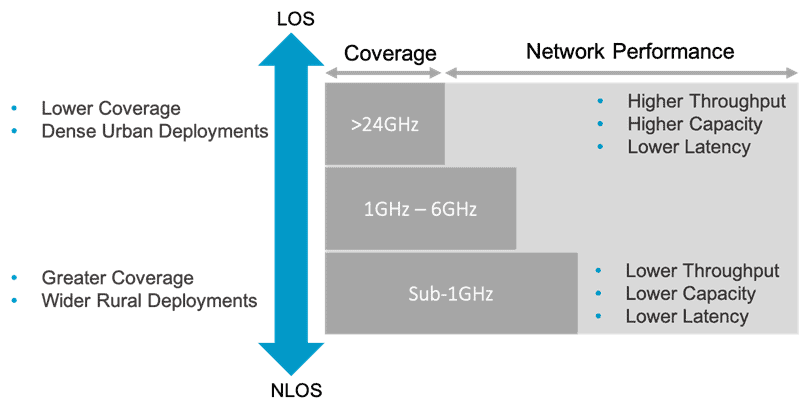Delivering enhanced 5G services
In terms of speed and performance, most of the initial 5G services have been similar to 4G. This makes sense as they rely essentially on the same 4G core (with some software enhancements), and although the new 5G new radio (5G NR) is used, it runs a low-frequency band spectrum. For initial 5G deployments, operators can provide customers a good balance of performance vs. coverage. At the same time, they invest in acquiring more spectrum at higher-frequency bands to take their 5G services to the next level.

As you move up the frequency scale from low to medium and high-frequency bands, the network performance improves considerably. However, this comes at the cost of the coverage. 5G enabled by high-frequency bands above 24 GHz, also known as Millimeter-wave or mmWave, delivers super-fast speeds over short distances proving Line-of-Sight (LOS) network coverage like Wi-Fi. Typically reaching a range of 100 meters, mmWave provides more capacity and bandwidth than any other frequency spectrum. High-frequency bands can transfer data with speeds of up to more than 10 gigabits (or 1250 megabytes) per second, an estimated 600x faster than low-frequency bands used for 4G and initial 5G rollouts. In other words, a subscriber can download a 4k video in a second.
With the new mmWave using an increased carrier bandwidth, more subscribers can be served by the same cell, so the customer experience is significantly enhanced. For operators, mmWave offers lots of spectrum (a scarce resource) at lower prices and improves the service provided to subscribers. In 4G and 5G NR running low-frequency band, an operator may only have ten MHz of bandwidth to offer subscribers, whereas, in high-frequency bands, the operator has access to between a hundred and two hundred MHz. It is like taking an existing highway and adding twenty new lanes to it, meaning that significantly more traffic can flow in densely populated areas at much faster speeds. This spectrum also brings advantages for indoor coverage, with mmWave having the propagation characteristics to avoid inter-cell interference. Millimeter-wave delivers the types of speeds and performance that will enable next-generation use cases and could extend the reach of fast connectivity to rural areas through Fixed Wireless Access (FWA).
Optimizing 5G RAN to ensure a consistent customer experience
LOS coverage mmWave is susceptible to interference from obstacles like trees and buildings and has difficulties penetrating through materials. As radio frequencies get higher, they act like radar, bouncing off things instead of going through them. So, operators will need to smartly monitor the customer experience to assure that subscribers are not riding high on a mmWave and then plummeting down into still water as they transition from 5G RAN running low to high-frequency bands. In the end, the subscriber needs a consistent customer experience, particularly in transitioning from 4G areas and in handovers between cells running in high-frequency band spectrum vs. low and medium band spectrum. Some other challenges that operators need to manage in deploying mmWave.
Deploying greenfield technologies
4G RAN a known quantity, but 5G RAN is a greenfield technology. Many operators are also opting to virtualize their 5G RAN. This can be in the form of Open RAN or Open vRAN. Open RAN (ORAN) is about splitting a Base Transceiver Station (BTS) into three parts and introducing one new network function, with open interfaces between these parts. Virtualized RAN (vRAN) means that the Baseband functions, such as L1, L2, L3, and transport processing, or at least some of them, are run by General Purpose Processors (GPP) on top of any Commercial off-the-Shelf (COTS) platform. (Before vRAN baseband functions run on purpose-built hardware). Moving to Open vRAN makes access networks more flexible and brings down the cost of managing and maintaining the network. However, this is a greenfield technology for all operators that need to be learned, and the technology needs time to mature.
Ensuring a consistent customer experience for 5G
Because coverage is limited, the customer experience change can be huge, going from a standard 5G NR cell to a 5G mmWave cell. So, operators need to carefully monitor the quality of experience for subscribers so that the change in the customer experience is not drastically different—the same for throughput. Operators need to ensure that throughput does not parachute from Gigabits to Megabits in a few seconds transitioning the subscriber from blistering 5G mmWave speeds to much slower 4G speeds in the blink of an eye. Smartly monitoring the handover and transitions from these cell sites is critical and must be part of any assurance portfolio deployed by operators.
Optimizing cell location and coverage
With their LOS coverage, mmWave cells are deployed outdoors in dense urban areas where there is a good concentration of subscribers, in a shopping mall, at the seafront, around airports, and train terminals. They will be positioned on lighting posts, and advertising stands rather than rooftops. These deployments will provide multi-gigabit speeds with virtually unlimited capacity for a vast number of subscribers. Millimeter-wave will also be used indoors to complement existing wireless services offered by Wi-Fi. Inside convention centers, concerts, stadiums. However, with their limited coverage, the placement and optimization of these sites are critical. There are lots of challenges for operators as they roll out this technology and configure each site. An automated assurance portfolio can address those challenges and provide your subscribers with a better customer experience.
Delivering on the promise of 5G enabled by mmWave
By deploying an automated assurance solution that is probe-based and monitors the end-to-end network from the RAN to core, operators can gain visibility into this greenfield technology. Operators can then optimize and manage their RAN deployments and integrate them into their legacy network, ensuring that subscribers receive an excellent customer experience.
A probe-based solution needs to fully support RAN/vRAN/O-RAN/O-vRAN to offer real-time subscriber analytics and advanced end-to-end troubleshooting capabilities by monitoring both the control and user plane. This helps operators pinpoint customer-affecting network degradations and perform root cause analysis to rectify issues quickly. This subscriber-based coverage provides Key Performance Indicators (KPIs) and Key Quality Indicators (KQIs) for 5G RAN running high-band spectrum, enabling you to optimize your mmWave and sub-6 GHz band deployments.
This also provides customer-focused indicators into handovers and transitions from cells to optimize the customer experience and ensure that early adopters of 5G receive value for their money. Deploying an automated assurance solution will help operators smartly monitor their mmWave cell locations and optimize coverage. Once initial sites are deployed, automated assurance will also help operators pinpoint the best spots to place other sites and plan neighboring cells.
As mmWave rollouts are a greenfield deployment, an automated assurance portfolio can prioritize cell deployment locations and provide a list of potential cell locations (based on subscriber usage and demand).
Conclusion: Automated Assurance is Critical
5G RAN running mmWave is a new and exciting greenfield technology that can significantly boost your customers’ service offering. However, deploying an automated assurance solution that includes RAN monitoring will be essential to ensuring that 5G RAN performs well and delivers on its promise to customers. Monitoring and optimizing mmWave is part of our advanced assurance solution, RADCOM ACE. The solution is already being used by our customers today to monitor, analyze, and detect degradations in 5G RAN performance in real-time. With integrated AI/ML capabilities for RAN optimization, RADCOM ACE can automate this entire process and predict network issues while assuring a superior customer experience. Once these greenfield deployments are integrated into the network, RADCOM ACE will enable operators to continue optimizing their 5G RAN.
RADCOMize your Radio Access Network for 5G with RADCOM. To learn more about RAN monitoring, click here and our solution brief on optimizing your 5G RAN running mmWave click here.

